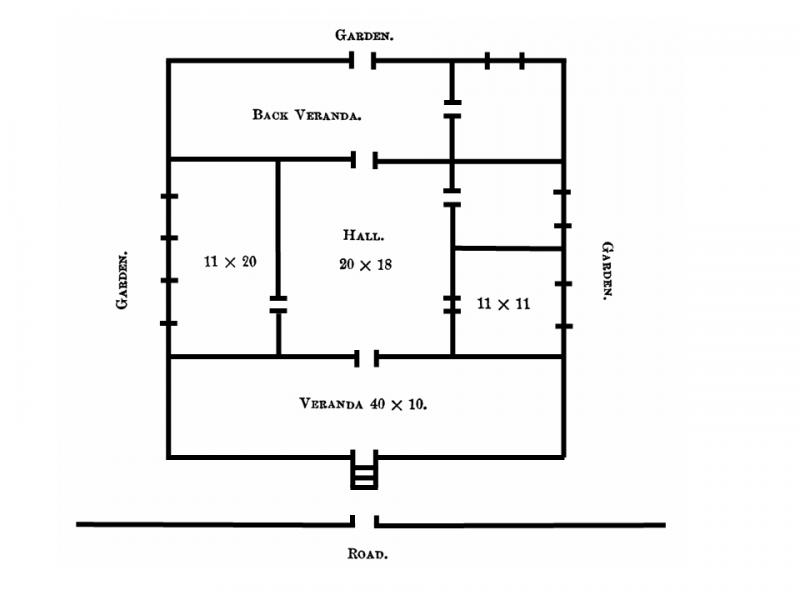My last post discussed attempts which had been made to locate the house which Wallace lived in on the Indonesian island of Ternate, but it has occurred to me that some readers may not know what is so special about this house; so let me explain:-
Wallace made Ternate his base during the second half of his collecting expedition to the 'Malay Archipelago' and he rented a house there and lived in it on several occasions between early January 1858 and June/July 1861. In his book The Malay Archipelago he writes the following about the house:
"On the morning of the 8th of January, 1858, I arrived at Ternate, the fourth of a row of fine conical volcanic islands which skirt the west coast of the large and almost unknown island of Gilolo [Halmahera]. The largest and most perfectly conical mountain is Tidore, which is over four thousand feet high--Ternate being very nearly the same height, but with a more rounded and irregular summit. The town of Ternate is concealed from view till we enter between the two islands, when it is discovered stretching along the shore at the very base of the mountain. Its situation is fine, and there are grand views on every side. Close opposite is the rugged promontory and beautiful volcanic cone of Tidore; to the east is the long mountainous coast of Gilolo, terminated towards the north by a group of three lofty volcanic peaks, while immediately behind the town rises the huge mountain, sloping easily at first, and covered with thick groves of fruit trees, but soon becoming steeper, and furrowed with deep gullies. Almost to the summit, whence issue perpetually faint wreaths of smoke, it is clothed with vegetation, and looks calm and beautiful, although beneath are hidden fires which occasionally burst forth in lava-streams, but more frequently make their existence known by the earthquakes which have many times devastated the town.
I brought letters of introduction to Mr. Duivenboden, a native of Ternate, of an ancient Dutch family, but who was educated in England, and speaks our language perfectly. He was a very rich man, owned half the town, possessed many ships, and above a hundred slaves. He was, moreover, well educated, and fond of literature and science--a phenomenon in these regions. He was generally known as the king of Ternate, from his large property and great influence with the native Rajahs and their subjects. Through his assistance I obtained a house, rather ruinous, but well adapted to my purpose, being close to the town, yet with a free outlet to the country and the mountain. A few needful repairs were soon made, some bamboo furniture and other necessaries obtained, and, after a visit to the Resident and police magistrate, I found myself an inhabitant of the earthquake-tortured island of Ternate, and able to look about me and lay down the plan of my campaign for the ensuing year. I retained this house for three years, as I found it very convenient to have a place to return to after my voyages to the various islands of the Moluccas and New Guinea, where I could pack my collections, recruit my health, and make preparations for future journeys…
Floor plan of the Ternate house from The Malay Archipelago. Measurements are in feet.
A description of my house (the plan of which is here shown) will enable the reader to understand a very common mode of building in these islands. There is of course only one floor. The walls are of stone up to three feet high; on this are strong squared posts supporting the roof, everywhere except in the verandah filled in with the leaf-stems of the sago palm, fitted neatly in wooden framing. The floor is of stucco, and the ceilings are like the walls. The house is forty feet square, consists of four rooms, a hall, and two verandahs, and is surrounded by a wilderness of fruit-trees. A deep well supplied me with pure cold water--a great luxury in this climate. Five minutes’ walk down the road brought me to the market and the beach, while in the opposite direction there were no more European houses between me and the mountain. In this house I spent many happy days. Returning to it after a three or four months’ absence in some uncivilized region, I enjoyed the unwonted luxuries of milk and fresh bread, and regular supplies of fish and eggs, meat and vegetables, which were often sorely needed to restore my health and energy. I had ample space and convenience for unpacking, sorting, and arranging my treasures, and I had delightful walks in the suburbs of the town, or up the lower slopes of the mountain, when I desired a little exercise, or had time for collecting...
Just below my house is the fort, built by the Portuguese, below which is an open space to the beach, and beyond this the native town extends for about a mile to the north-east. About the centre of it is the palace of the Sultan, now a large untidy, half-ruinous building of stone."
The crucial information which enables the house (or the site it was on) to be identified is therefore:-
1) That the structure and the floor plan are as Wallace described them.
2) There is a deep well in the garden (whether behind or to one side of the house he doesn't say).
3) The beach is five minutes walk away.
4) There is (or was) an old Portuguese fort between the house and the beach.
5) The Sultan's palace is (or was) about half a mile to the north-east of the house.
John Wilson in his 2000 book The Forgotten Naturalist: In Search of Alfred Russel Wallace also dismisses what Ian Cowan (see last post: http://wallacefund.info/en/news-about-alfred-russel-wallaces-ternate-house) calls the "Sultan's House" as being a candidate, saying that it was "not quite in the right area, nor were the rooms the right size." Wilson goes on to say that the only fort in the neighbourhood is a Dutch one, Benteng Oranje, and he suggests that this was probably the fort Wallace mentioned - Wallace being mistaken in thinking that it was built by the Portuguese. After some discussion with local people Wilson found a house with a well in the garden which was situated "behind the old Dutch fort, not far from the market and the beach". This had been built 50 years before by a Mr Aquil on an empty plot of land and Wilson wondered whether Wallace's house might once have stood there. It will be interesting to learn whether the plot recently identified on Ternate as being the site of Wallace's house is this one.
The main reason the house is legendary and is worth turning into a museum, is that Wallace was living there when he posted his famous letter and his essay on natural selection to Charles Darwin on the 9th March 1858. Note that although Wallace’s essay was marked as having being written on Ternate in February 1858, this cannot have been the case since Wallace’s unpublished Malay Field Journal in the Linnean Society of London shows that he was on Gilolo [Halmahera] during the whole of February, only returning to the neighbouring island of Ternate on 1 March. It is probable that he wrote “Ternate” on the essay simply because this was the island where he had his base, and because it was his postal address. Alternatively, he got the month wrong and should have written “March” instead of “February.” However, this would have been a curious error to make as he wrote a letter to Frederick Bates which he dated 2nd March 1858 (original in The Natural History Museum, London, catalogue number WP1/3/42), and which was posted back to Britain on the same mail ship as his Ternate Essay. Why he never corrected either the date or the place of his discovery in his published accounts of this event is curious. For more details about Wallace's discovery of natural selection see http://wallacefund.info/en/biography-wallace
POSTSCRIPT
After the above was written I discovered that "Benteng Oranje" (which has also been called Fort Oranje, Fort Orange or Castle Orange) is mentioned in Wallace's 1879 book Australasia. In this book it says that the fort was reputed to have been built on "the foundations of an old Portuguese structure", which may account for why Wallace called it a "Portuguese fort".


Add new comment